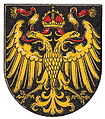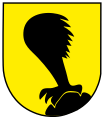Imperial banner of the Holy Roman Empire

The imperial banners , also imperial flag or imperial standard , the flag as insignia , and the flag colors black and gold and coat of arms images (black and gold eagle, silver and red cross) of the Holy Roman Empire , have been used since Emperor Heinrich VI. († 1197) attested.
As an army or storm flag , this banner - in the form of a standard - was directly connected to the kingdom , for the kingdom was entrusted to the king, and only the king could declare imperial war ; so it was a symbol of imperial law. It was considered the trademark of the riches , was even referred to as the holy kingdom . If the king did not appear personally as a general , he transferred the kingdom of pannyr to the commander whom he entrusted with this task.
The Reich Banner
According to the Res Gestae Saxonicae Widukinds von Corvey , army flags were already in use under Heinrich I and Otto the Great with the Archangel Michael , who as the leader of the heavenly hosts and as the conqueror of Satan was patron of the Carolingian Empire and later of Eastern Franconia from 819 .
Imperial flag: Silver cross on red
After closed helmets had made it necessary to mark combatants , the imperial flag , a silver (white) cross on a red background, sometimes also provided with a pennant , was created around the 12th century to distinguish it from other crusader contingents. Since the emperor already used the eagle, the use of the cross banner was obvious, especially since Saint Michael was often depicted with such a flag or shield. "Des Rîches van / das kriuce should bear with rights" (Wolframs von Eschenbach Willehalm 332, 22-23), the sacred dimension and claim of the empire as a sacred empire is also expressed in the cross.
It was used by the king or commander as the military flag of royalty for the war of the empire (in this sense, it is used in the Roland song ) and was considered to be the "war mark of the rich" (Otacher). It was the epitome of the empire and a stately symbol in the possession of the king, like insignia and the empire itself, but could be sent to them by the ruler at the request of the estates in the war against peace breakers. In 1415/1423 Sigismund handed over the imperial banner to the Confederates in the fight against the outlawed Habsburg. Although these increasingly withdrew from the Reich, they continued to carry the banner in the form of the Swiss cross even after independence from the Reich . A song written in 1515 by Hans Wik from Lucerne bears witness to this: Switzerland is what I praise, if it does honor, wherever it goes into the field, it leads the holy rich. In addition, the Danish flag could also have its origin or a model in the imperial flag .
Over time, the cross banner of the empire was replaced by the eagle banner of the ruler. The awareness that the cross flag was the real imperial flag had not yet disappeared in the middle of the 15th century. So the Frankfurt farewell to the Turkish procession in 1454 still determines: "The keyserliche here [is] under the baners of the holy krewtzes of the empire" are called out. In 1683 the imperial banner was used for the last time when Vienna was dismissed.
|
|
On red the silver cross as a storm flag (vexillological representation of a banner ( standard ) with pennant ) |
King's flag: black eagle on gold
The king's flag shows a black eagle with a red weapon on a gold background. The eagle has been found since Friedrich Barbarossa in the 12th century. The oldest pictorial evidence of this can be found in the Codex Balduini. The use of two different flags for rulers and empires refers to a characteristic feature of the Holy Roman Empire: the coexistence of king / emperor and empire. Like king and kingdom, the flags and color combinations enter into a dualism: Albrecht and Adolf competed in their battle, both of them armed in black and gold, their storm flags, however, corresponded to the imperial banner red with white cross.
Since the eagle originally symbolized royalty, i.e. it was a royal eagle, the term 'imperial eagle' is strictly incorrect. In the course of the 14th century, however, the eagle was no longer perceived as an exclusive symbol of royalty, but as an imperial coat of arms ( imperial eagle ). On the occasion of the funeral of Charles IV, an Augsburg chronicler writes of the use of the rulership symbol: “According to the black eagle of the rich in a guldin veld ... then the fan of the hailgen rich, ain wizz crütz with a long nail in a rotten veld uff ainem verdackten ros. "
After the eagle coat of arms is also perceived as the imperial coat of arms, the differences between the two and the colors begin to blur. The competing dualism becomes heraldically visible in 1398, when the city of Würzburg affixed the king's eagle to the town hall during the city war and flags the red and white banner as a symbol of independence. In the following years there was no longer any clear distinction: In the 15th century. one has "thrown up the Reich's panier and let the eagle with a head in a precious gulden vanen ... fly"
Since King Sigismund (1433), the banner has shown a double-headed double -headed eagle (until 1806), analogous to the changes in imperial seals and coats of arms , while the single-headed eagle is retained in the symbols of the king.
For the coronation procession in Rome in 1452, Friedrich III. expressly only the eagle banner, probably in order to publicly express a closer bond between the empire and the ruler by using the ruler's banner. In 1488 the imperial double-headed eagle flag was finally raised as “des Richs Houptbaner” during the campaign in front of Ghent, and for the Reichstag in Worms in 1495 it says: “The vierd baner was yellow with a black nobility of h. Roman Richs storm fan. ” With that, the eagle banner had changed from the king 's banner to the imperial storm flag and prevailed over the cross banner of the empire. Only a red swivel on the eagle banner and the imperial storm flag reminded of the old cross banner from then on.
Other important flags of the empire
|
|
Reich racing flag : black and white divided with crossed red swords. In addition to the imperial flag (the actual imperial banner) and the imperial sword , the imperial marshal hadto wearthe racing flag on the emperor's side. (here: coat of arms banner ) |
|
|
Since the 16th century, the army of modern times has also used the image of the Madonna as a standard (here: Bavarian Madonna, Catholic League , Thirty Years War ) |
Contemporary and historicizing images
- The flag
Bern Minster , choir window, between 1441 and 1455: knightly standard-bearer
(with the red pennant, which is derived from the crusader flag)Adam Bishop, 1490: First Crusade , Siege of Antioch , with imperial banner and storm flags
(the depiction of the 1st Crusade with these colors should not be historically correct)Albrecht Altdorfer: Emperor Maximilian's triumphal procession , scene: Mayland rebounds to the empire , around 1513–1515: Emperor Maximilian with imperial banner and coat of arms
(the second banner is that of the Visconti of Milan)
- as a coat of arms
Codex Manesse , Zurich between 1305 and 1340, fol. 6r: Heinrich VI. , with his shield and his helmet with crest , sword and scepter
Hand registry, around 1446. Coat of arms of Friedrich III. as the Roman-German king
Albrecht Dürer, 1512/1514: Karolus Magnus . With the imperial regalia (1)
Usage today
Imperial flag
- Imperial flag
Savoy , 12th century (?)
Pisa , awarded by Frederick I Barbarossa , later 12th century.
Order of Malta / Order of St. John , 13th century (including Maltese cross also: Malta and others)
Vienna , unsafe since 1228, with an eagle since 1327
Switzerland (derivation uncertain, maybe also: Canton Schwyz )
Flag of Denmark (Dannebrog), ca.1370–1386. (Derivation uncertain , including numerous derivations )
Gdansk 14./15. Century
The red and white of the imperial banner enjoyed enormous popularity in the High Middle Ages, from which the flag of Austria (above the shield ), the flag of Poland and numerous city coats of arms are probably derived .
King's flag
- Territorial coat of arms
Weimar Republic : Reich coat of arms 1919–1935
Black and gold also show: Baden-Württemberg , Electorate of Saxony
- City arms
Aachen (the old, one-headed eagle)
Donauwörth (dimpled double-headed eagle)
Krems on the Danube , awarded in 1463 to Emperor Friedrich III. (inverted colors, the city flag also shows black and gold)
Villach ( eagle catch , 1240 oldest city seal in Austria)
The black and gold coat of arms can be found numerous, especially in the free imperial cities :
- Black in gold: Aachen, Besançon , Deventer , Donauwörth , Dortmund , Essen , Esslingen , Friedberg (double-headed eagle) , Goslar , Kaufbeuren ( split right ) , Lübeck , Markgröningen , Memmingen ( split right ) , Nuremberg ( split right ) , Pfullendorf , Rottweil , Tulln , Überlingen , Wimpfen ; no imperial cities: Cheb ( divided above) , Villach, Trieste
- Gold in black: Isny , Kempten (today sp. Right, formerly double-headed eagle) , Nördlingen ; no imperial city : Krems
The imperial eagle is even more common in other colors (e.g. Frankfurt am Main ).
See also
- Quaternion eagle , the eagle covered with the coat of arms as a symbol of emperor and empire
- Flag of Austria - on the specific history of the flag of the Habsburg emperors 1438 ( Albrecht II. ) –1806 ( Franz II. ) And black and gold ("imperial colors ") for Austria
- Federal coat of arms of Germany: Middle Ages
literature
- Johann Georg von Kulpis : Thorough deduction that the HochFürstl. House of Würtemberg legally entitled to the Reichs-Pannerer- or Reichs-Fendrich-Ambt, Prædicat and Insigne, already from several Seculis, and therefore without offending the same traditional prærogatives, no other choir or prince could be awarded again. Lorber, Stuttgart 1693 (digitized version)
- Exchange letters from the ReichsBannier. Holding within a proof of the difference between the same and the Würtembergian storm flag . Förster, Hanover 1695 (digitized version)
- Herbert Obenaus : Law and constitution of the companies with St. Jörgenschild in Swabia. Investigations on nobility, unification, arbitration tribunals and feuds in the fifteenth century (= publications of the Max Planck Institute for History. Volume 7, ZDB -ID 121375-1 ). Vandenhoeck & Ruprecht, Göttingen 1961 (at the same time: Göttingen, Univ., Phil. Diss., 1959).
- Ernst Schubert : King and Empire. Studies on the late medieval German constitutional history (= publications of the Max Planck Institute for History, Volume 63). Vandenhoeck & Ruprecht, Göttingen 1979, ISBN 3-525-35375-8 , pp. 358-366: King and Empire in the heraldic language of colors. (At the same time: Erlangen-Nürnberg, Univ., Habil.-Schr.).
- Douglas Miller, John Richards: Landsknechte. 1486-1560. Illustrated by Gerry Embleton. Siegler, Sankt Augustin 2004, ISBN 3-87748-636-3 . (with color plates including: Reich racing flag).
Web links
Individual evidence
- ↑ a b c d e f g h Peter Diem: Red-White-Red through the centuries. The true story of the Austrian colors. (also PDF ) Retrieved May 15, 2009 .
- ^ Alfred Mell: The flags of the Austrian soldiers through the ages. Bergland, Vienna 1962, p. 29 - after Diem
- ↑ The coats of arms of the German sovereigns - J. Siebmacher's great coat of arms book I. Volume 1. Department 2–5. Part of Nuremberg 1909–1929.
- ^ Peter F. Kopp: Swiss Cross. In: Historical Lexicon of Switzerland .
- ↑ The first illustration of the Danish flag comes from an illustration in the Dutch book of arms, Gelre (approx. 1370–1386). State Archives of Denmark
- ^ Johann Siebmacher : New Wappenbuch. 1605, sheet 219 ReÿchsStätte , sheet 220 ReÿchsStätte and other places


























